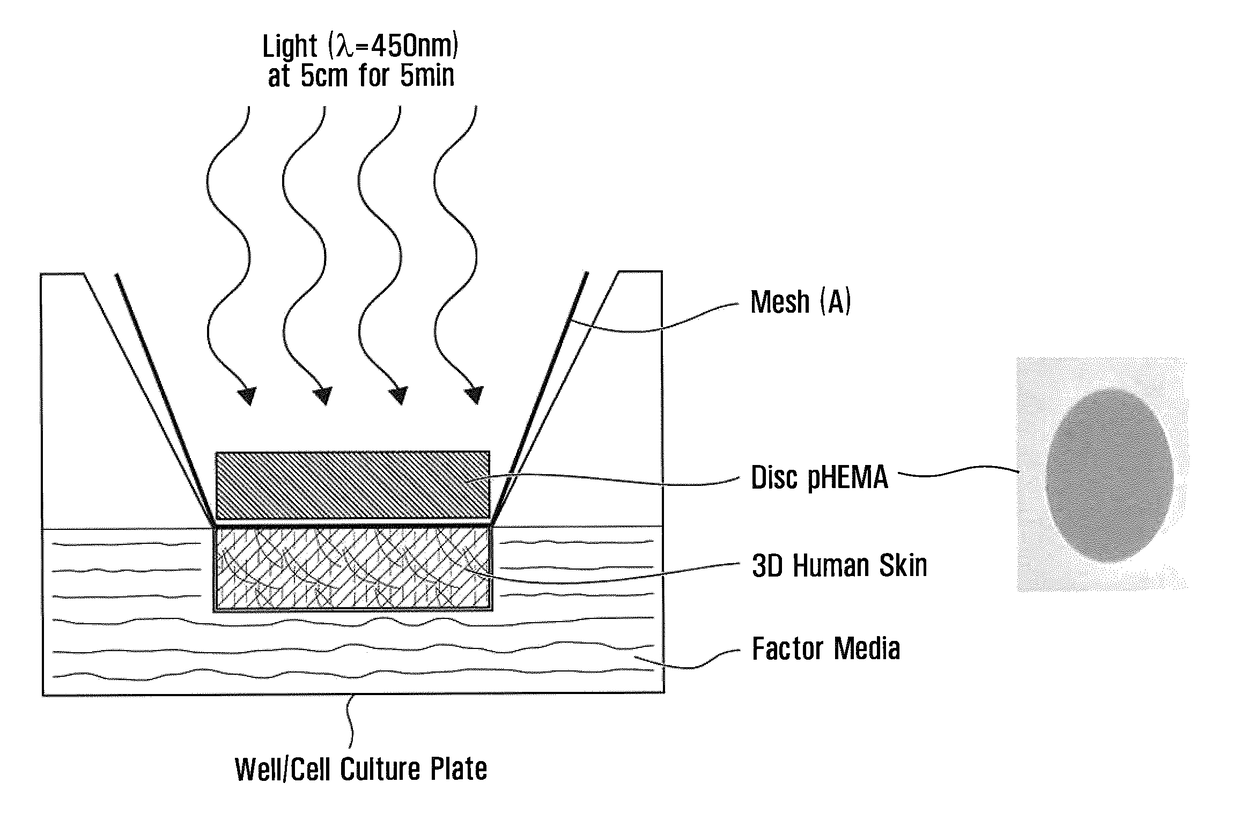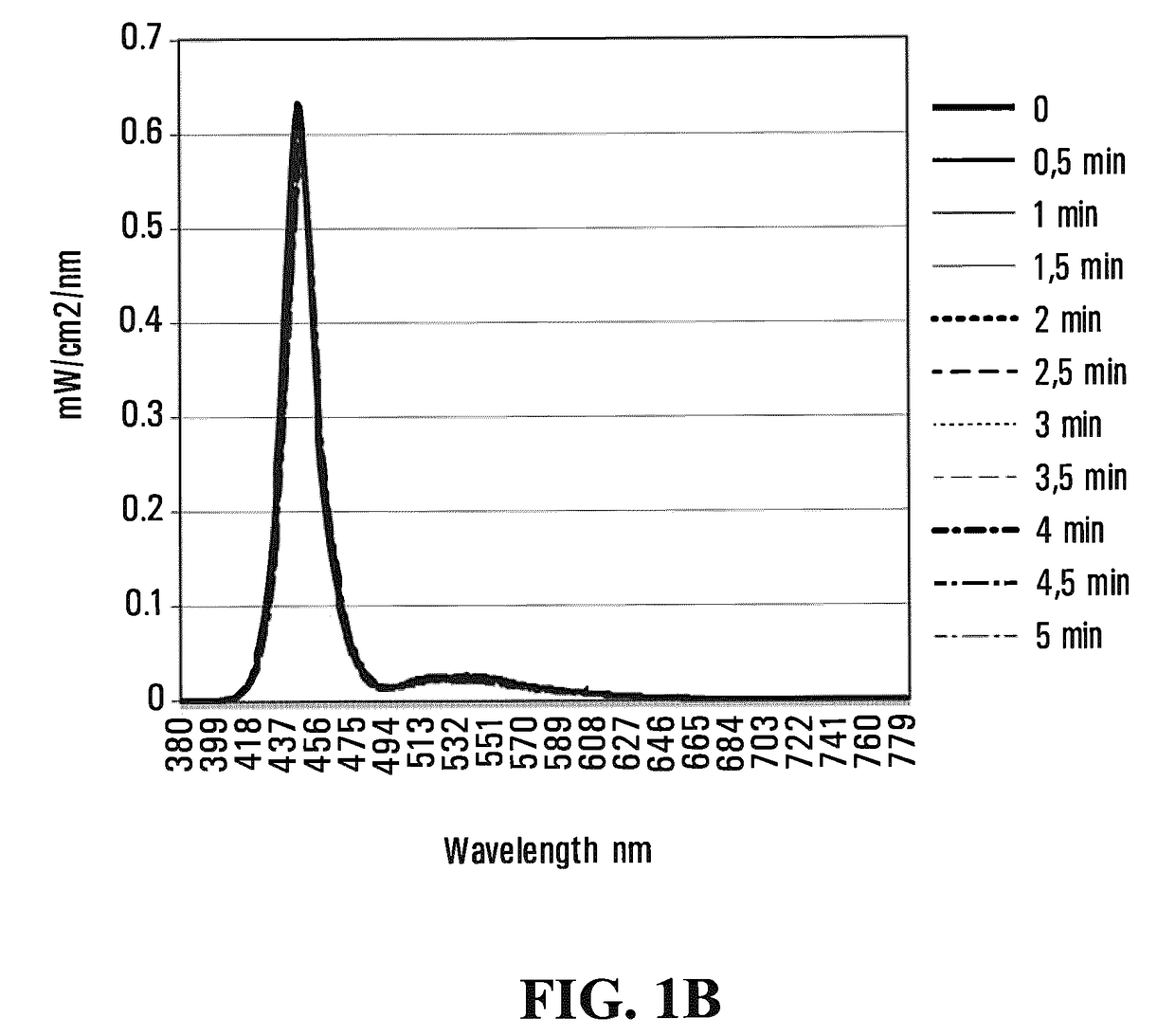Emissive polymeric matrices
a polymeric matrix and polymer technology, applied in radiation therapy, non-active ingredients in pharmaceuticals, therapy, etc., can solve the problems of reducing the ability of the three-dimensional network to reverse the deformation, reducing the effect of the three-dimensional network ability, and reducing the effect of the inflammatory cytokine production
- Summary
- Abstract
- Description
- Claims
- Application Information
AI Technical Summary
Benefits of technology
Problems solved by technology
Method used
Image
Examples
example 1
Preparation of a Solid Disk of Polymerized HEMA Incorporating Eosin Y and Fluorescein
[0202]A solid disk of polymerized HEMA incorporating Eosin Y and Fluorescein was prepared by mixing together the following materials in the order given below:
1) Pure water-Hyclone (30 ml) #SH30529.02 from Thermo Scientific;
2) Benzoyl peroxide (100 mg) (BPO) #517909 from Sigma Aldrich Co. USA, which was used as initiator;
3) Eosin Y (50 mg) D&C Red22 #2012-27447, from Spectra Colors Corporation;
4) Fluorescein (50 mg) D&C Yellow 8 #2012-27110, from Spectra Colors Corporation;
5) 2-Hydroxyethyl methacrylate (70 ml) (HEMA) #477028, from Sigma Aldrich Co. USA; and
6) Ethylene glycol dimethacrylate (500 μl) (EGDMA) #335681, from Sigma Aldrich Co. USA, which was used as cross-linker.
[0203]Eosin Y and Fluorescein were added to liquid monomer pre-polymerization.
[0204]Polymerization was carried out in a nitrogen atmosphere for 5 hours at 70° C. The mixture was placed in a mould (glass Erlenmeyer or plastic conta...
example 2
Preparation of a Hydrogel of pHEMA Incorporating Fluorescein
[0206]A hydrogel of polymerized HEMA incorporating Fluorescein was prepared by mixing together the following materials:
1) Pure water-Hyclone (70 ml) #SH30529.02, from Thermo Scientific;
2) Benzoyl peroxide (100 mg) (BPO) #517909, from Sigma Aldrich Co. USA, which was used as initiator;
3) Fluorescein (50 mg) D&C Yellow 8, #2012-27110, from Spectra Colors Corporation;
4) 2-Hydroxyethyl methacrylate (30 ml) (HEMA) #477028, from Sigma Aldrich Co. USA; and
5) Ethylene glycol dimethacrylate (500 μl) (EGDMA) #335681, from Sigma Aldrich Co. USA, which was used as cross-linker.
[0207]Polymerization was carried out in a nitrogen atmosphere in 5 hours at 70° C. Once polymerized, the hydrogel was kept in a sealed container to avoid dehydration. FIG. 3 shows the light emission spectra of a 2.3 mm thick pHEMA hydrogel during 5 minutes of illumination. Table 3 below shows the emission data corresponding to FIG. 3.
TABLE 3mw / cm2 at 5 cm2.30 mm,...
example 3
Preparation of Microspheres of Polymerized HEMA Incorporating Eosin Y in Silicon Matrix
[0208]Microspheres of polymerized HEMA incorporating Eosin Y were prepared by mixing together the materials of in the order given below in vegetable oil and in a silicone matrix (1:15 (v / v)), while stirring at 600 rpm.
1) Pure water-Hyclone (30 ml) #SH30529.02, from Thermo Scientific;
2) Benzoyl peroxide (100 mg) (BPO) #51790, from Sigma Aldrich Co. USA, which was used as initiator;
3) Eosin Y (100 mg) D&C Red22 #2012-27447, from Spectra Colors Corporation;
4) 2-Hydroxyethyl methacrylate (70 ml) (HEMA) #477028, from Sigma Aldrich Co. USA; and
5) Ethylene glycol dimethacrylate (500 μl) (EGDMA) #335681, from Sigma Aldrich Co. USA, which was used as cross-linker.
[0209]Polymerization was conducted in a nitrogen atmosphere in 4 hours at 60° C. Toluene was obtained from Fisher #062843. Ethyl ether was obtained from Fisher #124158 and was used to remove any traces of unreacted monomers. The particles were rin...
PUM
| Property | Measurement | Unit |
|---|---|---|
| pore size | aaaaa | aaaaa |
| thickness | aaaaa | aaaaa |
| diameter | aaaaa | aaaaa |
Abstract
Description
Claims
Application Information
 Login to View More
Login to View More - R&D
- Intellectual Property
- Life Sciences
- Materials
- Tech Scout
- Unparalleled Data Quality
- Higher Quality Content
- 60% Fewer Hallucinations
Browse by: Latest US Patents, China's latest patents, Technical Efficacy Thesaurus, Application Domain, Technology Topic, Popular Technical Reports.
© 2025 PatSnap. All rights reserved.Legal|Privacy policy|Modern Slavery Act Transparency Statement|Sitemap|About US| Contact US: help@patsnap.com



